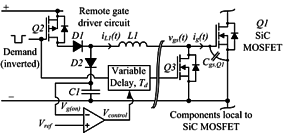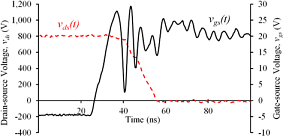 Resonant gate drivers for SiC MOSFETs
Resonant gate drivers for SiC MOSFETs
Resonant gate drivers are not generally used in commercially available converters, due to the perceived additional complexity. However, there are some striking advantages over conventional gate drivers. These silicon gate drivers can be located at a safe distance from wide-bandgap power devices with a higher thermal rating. And, the energy used to charge the gate can be recycled. At MHz switching frequencies this becomes significant. In the shown example, a current is set up in inductor L1, which is then re-routed into the gate to turn on the SiC device.
 Conventional versus resonant gate driver for SiC
Conventional versus resonant gate driver for SiC
A conventional voltage source driver can create unwanted oscillations in voltage and current, as shown on the right. This leads to the risk of cross-talk between device gates, which could potentially lead to spurious turn-on of devices and resulting converter failure.
_opt.png) The resonant gate driver is seen, in the lower figure, to switch the SiC device faster with lower oscillation in the gate signal. A portion of the charge used to raise the gate voltage is recycled at turn-off. At switching frequencies above MHz this provides a significant increase in converter efficiency.
The resonant gate driver is seen, in the lower figure, to switch the SiC device faster with lower oscillation in the gate signal. A portion of the charge used to raise the gate voltage is recycled at turn-off. At switching frequencies above MHz this provides a significant increase in converter efficiency.
References
P. Anthony, N. McNeill, D. Holliday, “A First Approach to a Design Method for Resonant Gate Driver Architectures” IEEE Trans. Power Electronics, Volume: 27, Issue: 8, Aug. 2012.
PhD Opportunities
Interested in the electric revolution, future of transport or Power Electronics? We're looking for enthusiastic and motivated students to join the EEMG.
Fully funded PhD scholarships for Chinese students to carry out research at the University of Bristol
Contact
To trial our active gate driver ICs, please contact Bernard Stark.
We are keen to work with companies to develop drivers for specific applications, and to help other research groups and companies set up test benches using our ICs.